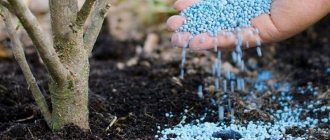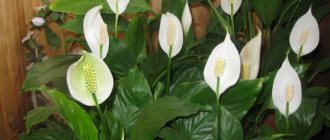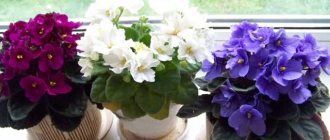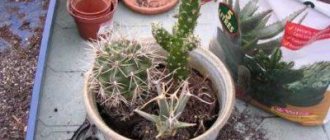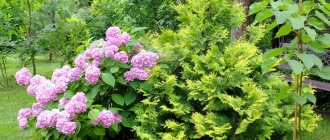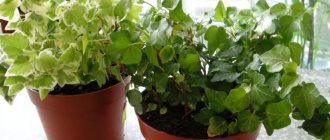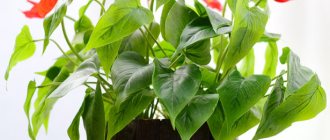Spathiphyllum, or, as it is popularly called, “female happiness,” grows in natural conditions in the tropics, in the partial shade of tall trees and dense vines. In its natural environment, it is reliably protected from wind and direct sunlight, has enough moisture and heat, and is fertilized by the humus-rich soil of tropical forests. To grow, develop and bloom at home, spathiphyllum needs additional nutrition, without which all care efforts may be in vain. What fertilizers should we feed “female happiness” and how to care for it so that it feels at home?
It is popularly believed that spathiphyllum can bring happiness to female representatives. Help unmarried people meet their grooms, and help childless people get pregnant.
What it is?
Fertilizing is an agrotechnical technique aimed at providing nutrition to the plant, as well as improving its qualities. Fertilizing can activate the growth process and the duration of flowering.
Correctly applied preparations can make the plant stronger, healthier and more resistant to diseases.
There are two ways to feed at home:
- Prikornevoy . In this case, fertilizer is applied at the root of the flower.
- Leaf , when the vegetative part is sprayed.
The importance of fertilizing for “female happiness”
Proper feeding is the key to the health and longevity of spathiphyllum .
In this case, you need to strictly observe the dosage, frequency, and also choose the right product. In addition, the timing of application is of great importance. At the initial stage (immediately after planting), spathiphyllum does not require fertilizers; the soil provides everything it needs. But over time, the soil becomes depleted, and the flower begins to “starve”. The reason is the limited space of the pot, and therefore the feeding area. This is why fertilizing is of great importance.
Otherwise, the decorative effect will be lost, the plant will become weak, the color of the foliage will become dull, growth and development will stop, and flowering will stop. Over time, such a flower dies.
What mineral complexes are effective for spathiphyllum?
The basis of balanced mineral solutions and mixtures includes phosphorus, potassium, nitrogen, and microelements - iron, manganese, magnesium, sulfur, boron and copper. These elements are necessary for plant crops to grow and develop:
- Potassium promotes the formation of cell membranes and water metabolism, strengthens the plant’s immunity, and affects its productivity.
- Phosphorus is involved in establishing energy balance, helps in the absorption of potassium, iron and zinc, and activates budding and ripening of seeds.
- Nitrogen stimulates shoot growth and improves photosynthesis.
The optimal combination of nitrogen, potassium and phosphorus should be 10:20:25.
The most effective products are those from the brands Azalea, Flower, Agricola or Master for flowering plants, Green House, Garden of Miracles, Mister Color, Florizel and Forte. The mineral mixtures azofoska, nitrophoska, and chelatin have also proven themselves well.
Do not forget about the benefits of ash infusion, rich in essential microelements. To prepare it, pour 2 liters of water into a glass of ash and leave for 5 days. Afterwards you need to pour 50 ml and dilute it in a liter of warm water.
How to choose the right time?
How to determine that a plant needs fertilizer?
The first sign that a flower is “hungry” is a deterioration in appearance . A plant that has not been fed for a long time has a pale color, becomes smaller in size and does not bloom. Sometimes there is uneven yellowing of the foliage, as well as its drying out.
In more detail, each sign indicates a lack of one or another element.
For example:
- If a flower is stunted, it lacks magnesium . This may also be indicated by lethargy and loss of turgor.
- If the leaves of a flower turn yellow , this indicates that it has used up its vitality and needs comprehensive feeding.
- Yellow leaves with green veins are evidence that the plant is suffering from chlorosis and lacks iron.
- If the green pet is healthy, but does not bloom , this is a sign of potassium and phosphorus deficiency. In this case, you need to change the drug.
When should the procedure not be performed?
Cases when applying fertilizer is not recommended:
- If less than a month has passed since the transplant. In this case, fresh soil will provide the flower with everything it needs and it does not need fertilizing.
- You should not feed a plant that is sick or infested with pests.
- A newly purchased flower should not be fertilized, as this can cause serious stress to it. And a plant under stress may drop its buds or stop blooming altogether. The adaptation period after purchase is at least 2 months.
- During the cold season, the flower hibernates and does not need nutrition. During this period, the amount of fertilizer is minimized or not applied at all.
- If there is a suspicion that the flower is sick with root rot, fertilizing is not carried out. In this case, measures should be taken to treat the flower and then apply fertilizer.
What time of year is best to fertilize?
The most optimal time for feeding is spring-autumn period . This is the time of active growing season after hibernation, when spathiphyllum is fertilized once a week.
The active growing season of spathiphyllum lasts from March to September.
When to fertilize
Women's happiness is an exotic plant, but this does not mean that it will need any special fertilizer mixtures.
The regularity of applications depends on the stage of development and growth characteristics. Throughout the growing season, it is necessary to fertilize spathiphyllum with both organic and mineral substances.
First of all, after waking up, you should think about the correct selection of organic matter. This is necessary to strengthen the root and immune systems and the development of green mass.
Only after this the plant is transferred to mineral complex products. If you do not stop adding organic matter in a timely manner, there will be no flowering. Reason: development of new foliage, not buds.
During the dormant period, no feeding activities are carried out. Otherwise, the flower will wake up earlier, but will not be able to bloom.
Frequency of such care
The frequency of fertilizing depends on the season and the condition of the flower.
- In spring, summer and early autumn, spathiphyllum is fed once a week. If the flower is in good condition, the frequency of fertilizing can be once every 14 days.
- From mid-autumn to early winter, spathiphyllum is fertilized once every 15-20 days. In winter - once a month.
If in winter the room temperature does not exceed 16 degrees, then the plant can not be fed until spring.
Step-by-step instructions: how to carry out the procedure?
You can find out how to fertilize the “female happiness” flower below.
Natural remedies
Not all flower growers like mineral fertilizers; some prefer to feed spathiphyllum with natural products that they prepare themselves.
The most effective home remedies:
- Coffee grounds . After the coffee has been drunk, the grounds are not thrown away, but poured into the pot. Subsequently, when watered, the coffee grounds will release beneficial substances to the soil.
- Tea leaves are an excellent source of vitamins and microelements for spathiphyllum. After the tea is drunk, the tea leaves are dried and added to the pot, it works in the same way as coffee grounds.
- Banana peel .
Before use, the peel is dried and then ground into powder, after which it is embedded in the soil. You can also prepare an infusion from banana peels. To do this, pour the skin of one banana with a liter of cold water and leave for 24 hours. After which the product is filtered and added to the pot once every 12 days. - Nettle infusion . To prepare, fresh nettle greens are crushed and poured with a liter of boiling water, then infused for 24 hours. The resulting concentrate is diluted in the proportion of 100 g of infusion per 1 liter of water.
- Milk serum . Before use, the serum is diluted with warm water in a ratio of 1:10. After which the plant is watered at the root.
- Succinic acid is a powerful growth stimulator. To feed, 1 tablet of the product is dissolved in 1 liter of water. The plant is fed by the root method.
Ready-made products
Before use, ready-made fertilizers are diluted with water in the proportions indicated on the package. In this case, only boiled or distilled water should be used. After the product has completely dissolved, water the flower with it, strictly observing the norm.
When feeding with root fertilizers, the products are applied strictly at the root, avoiding contact with the leaves.
If the spraying method is used, the product is diluted in a weaker concentration. In this case, the dosage is reduced by 2-3 times compared to that indicated on the package.
Preparations for feeding spathiphyllum:
- Special fertilizers “For aroids”.
- Universal products for indoor plants.
- Tablet preparations containing basic elements and trace elements.
- Liquid fertilizers for flowering.
The most popular of them:
- Bona Forte.
- Green house.
- Garden of Miracles.
- Master.
What fertilizers and fertilizers should I use?
Spathiphyllum is fed by the root method. Spraying is used when the plant needs urgent help.
You can fertilize “women’s happiness” with both ready-made complexes and those prepared with your own hands.
Among the means for feeding spathiphyllum it is recommended to use:
- Universal liquid nutritional compositions for indoor flowers.
- Special fertilizers for aroid or azale crops.
- Mineral mixtures in the form of tablets, granules or powder for flowering plants.
What fertilizers should I use before flowering?
In order for spathiphyllum to bloom, you must first add mineral preparations with potassium and phosphorus. Organic fertilizers are also necessary for indoor plants. For effectiveness, it is recommended to alternate the addition of mineral and organic substances.
How to care for the soil?
As you know, sapatiphyllum loves moist soil, both during the fertilizing period and at other times . Therefore, under no circumstances should it be allowed to dry out. Also, you should never apply fertilizer to dry soil, otherwise you may cause root burn.
Before adding, the flower is watered generously and left for a while to allow the water to drain. You should make sure that the earthen ball is saturated with water and only then feed the flower. After applying the product, the plant is watered again, and the soil is loosened to ensure “breathing” of the roots.
How to water the plant to bloom?
What to feed for flowering? To stimulate flowering, spathiphyllum is fed with potassium-phosphorus preparations . To do this, prepare a solution in the proportion of 1 g of product per 1 liter of water, and apply it by the root method.
In addition, organic fertilizers can be used to stimulate flowering. A mixture of mullein and water in a ratio of 1:30 is perfect. This product is used for root application.
Organic fertilizers should be applied with caution, since if they are in excess, you can get an abundance of green mass and a lack of flowering.
Consequences
As you know, fertilizers can bring not only benefits, but also harm. Moreover, both excess and lack of nutrients in the soil are harmful.
Lack of fertilizing
If spathiphyllum is constantly hungry, then you can forget about flowering . In addition, it will practically stop growing, the size of the leaves will decrease, and the color of the leaves will turn pale green. In addition, yellowing and partial death of the green mass will be observed. Such plants have weak immunity and are susceptible to fungal infections. If the situation is not corrected, the flower dies.
Excess
An excess of nutrients leads to the fact that the flower actively produces young shoots, but does not bloom. Such symptoms indicate excess nitrogen in the soil. In addition, an excess of mineral fertilizers can lead to the deposition of nitrates in the soil and the death of the plant.
One of the main signs of overfeeding is brown spots on the leaves . In this case, the application of drugs is stopped, and the flower is transplanted to another soil (is it possible to replant spathiphyllum in winter and how to care for it?). If everything is done correctly, after a month the flower will return to normal.
Fertilizing spathiphyllum is an integral part of care; in moderation it is always useful. However, don't get carried away. Excessive amounts of minerals in the soil can lead to poor results. If the flower is healthy, grows and blooms well, then regular watering and loosening the soil will be enough for it.
If you find an error, please select a piece of text and press Ctrl+Enter.
Symptoms of malnutrition in spathiphyllum
The lack of nutrients affects the condition of the plant. You can determine which elements spathiphyllum lacks by external changes:
- Small pale leaves are the first symptom of nutritional deficiency.
- Slow growth, lethargy of flowers, yellow leaves indicate a lack of magnesium and iron.
- If a plant does not bloom for a long time, then it lacks phosphorus.
- When leaf blades turn yellow unevenly, the flower needs boron and calcium.
- Spathiphyllum begins to fade after flowering due to the depletion of reserves - a nutritional complex is needed here to restore strength.
